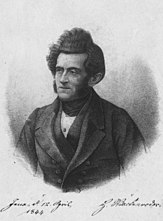Heinrich Wilhelm Ferdinand Wackenroder | |
|---|---|
 | |
| Born | 8 March 1798 |
| Died | 4 September 1854 (aged 56) |
| Nationality | German |
| Known for | Wackenroder solution |
| Scientific career | |
| Fields | Chemistry |
Heinrich Wilhelm Ferdinand Wackenroder (8 March 1798 in Burgdorf, Hanover – 4 September 1854 in Jena) was a German chemist.
In June, 1826 Wackenroder published his doctoral dissertation, “On Anthelminthics in the Vegetable Kingdom,” presented to Göttingen University, which earned him praise, and the Royal Prize.[1]
In 1827 he obtained his doctorate from the University of Erlangen, becoming an associate professor the following year at the University of Jena, where he worked with Johann Wolfgang Döbereiner (1780-1849). In 1836 he was appointed Professor ordinarius and Director of the Pharmacy Institute, later known as the Chemical-Pharmaceutical Institute. He became especially known for his discovery of carotin and his correspondence with Goethe. In subsequent years he became co-editor of Archiv der Pharmazie.
In 1826 Wackenroder isolated corydalin from Corydalis cava and in 1831 isolated carotin in an ether extract from carrots.[2][3] In 1845 he discovered the Wackenroder solution, a polythionic acid, resulting from the reaction of dilute sulphuric acid with hydrogen sulphide.